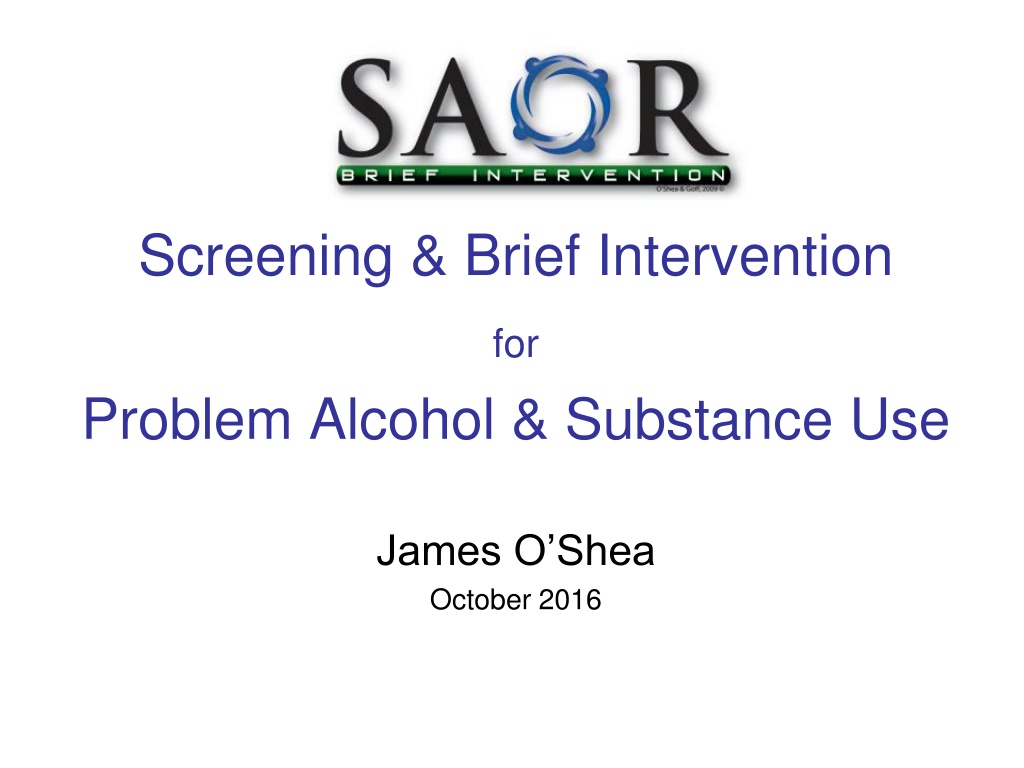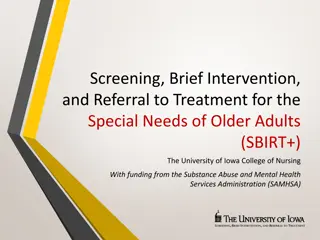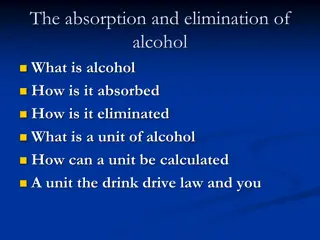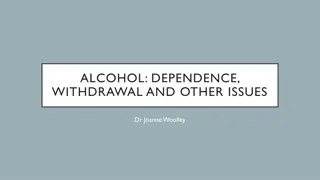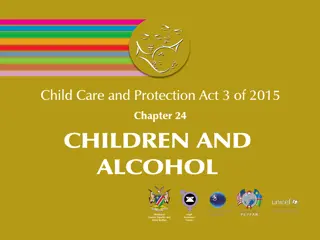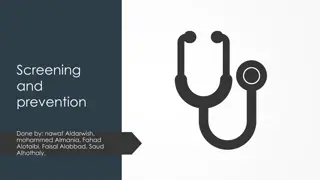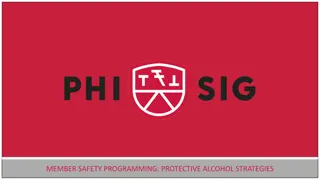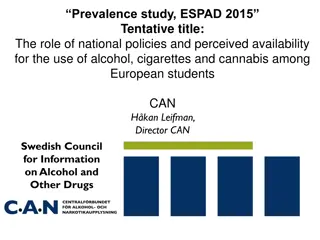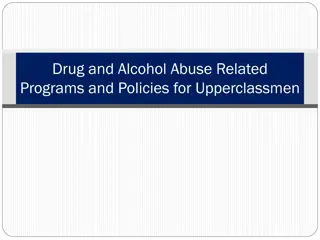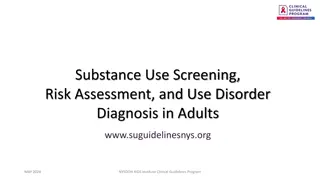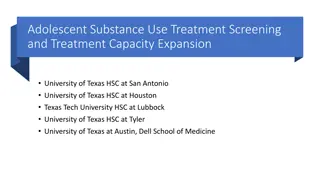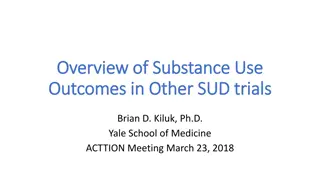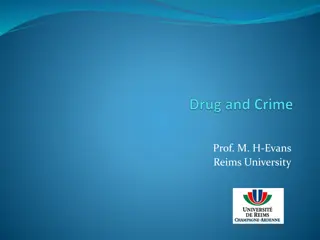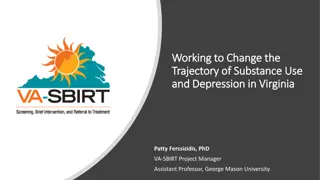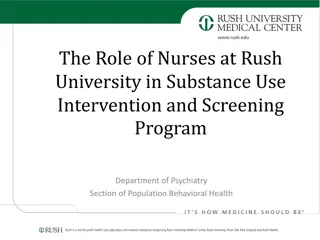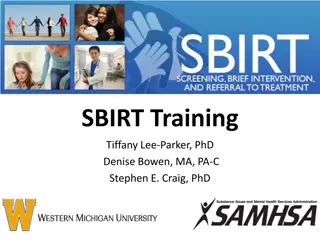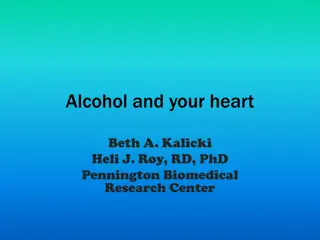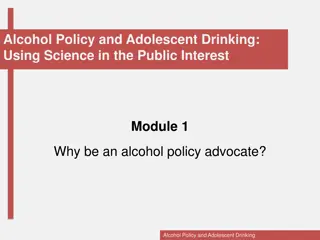SAOR Model: Screening & Brief Intervention for Problem Alcohol & Substance Use
A detailed overview of the SAOR Model focusing on screening and brief intervention for problem alcohol and substance use. It covers the key elements, background and training, evidence-based practices, rationale, and steps involved in the model's implementation.
Download Presentation

Please find below an Image/Link to download the presentation.
The content on the website is provided AS IS for your information and personal use only. It may not be sold, licensed, or shared on other websites without obtaining consent from the author. Download presentation by click this link. If you encounter any issues during the download, it is possible that the publisher has removed the file from their server.
E N D
Presentation Transcript
Screening & Brief Intervention for Problem Alcohol & Substance Use James O Shea October 2016
SAOR Model Model for Screening & Brief Intervention for problem alcohol & substance developed in 2009 Emerged from work in acute hospital settings Incorporates all the key elements of evidence based practice in Screening and Brief Intervention Disseminated nationally through national Social Inclusion office in diverse settings over past 7 years Now utilised in broad range of settings
Key Elements of SAOR Model SAOR = Irish word for free used as acronym to remember key elements S = Support A = Ask & Assess O = Offer Assistance R = Refer
Background & Training One of the aims of HSE Social Inclusion is to contribute to the achievement of improved health outcomes for persons experiencing substance misuse. SAOR - Brief Intervention integral part of this aim Training on SAOR led nationally by Ruth Armstrong - Project Manager Alcohol National panel of trainers established delivering training across 7 CHO areas SAOR accepted as part of European Union Reducing Alcohol Related Harm (RARHA) Project Good Practice Toolkit;
Based Upon Evidence & Emerging From Practice SAOR incorporates key aspects of models SBI proposed by; FRAMES (World Health Organisation, 2003) 5 A s Model (see Anczac and Nolger ,2003) WHO Brief Intervention Manual (Babor & Higgins Biddle, 2001) U.S. Department of Health and Human Services (NIAAA, 2005) Irish College of General Practitioners (ICGP, 2014, ICGP, 2006) SAOR 1st edition (O'Shea & Goff,2009)
Rationale SAOR model: Accentuates the support/relationship building aspect of SBI Sequences the intervention in a logical & user friendly manner Provides practitioners with a step by step guide to SBI Offers culturally appropriate model in Irish context
Rationale (ii) Includes all the key steps of: Building the therapeutic relationship Offering advice and feedback Offering assistance Ensuring appropriate referral & follow up
Screening Targets members of defined population to identify those: At risk of problem alcohol/substance use likely to benefit from intervention. Identifies those who: Drink or use substances at harmful levels Are beginning to experience problems Are showing signs of dependence
Screening & Brief Intervention (SBI) SBI involves the following; Assessment Interview using standardised, validated screening tools Feedback Level of risk Personalised Information & Advice Referral & Follow-up (if indicated)
Brief Intervention (BI) Any intervention that involves a minimum of professional time to help change behaviour....requiring anything from 5 minutes upwards Generally restricted to four sessions or less & delivered by non-specialist workers Investigate a potential problem & motivate an individual to begin to make a change Average session using SAOR may take 20 minutes
Evidence of Effectiveness of BI Numerous randomised clinical trials & systematic reviews have supported the use of BI in a range of settings including; Primary care Emergency Departments / Acute hospitals Outpatient clinics Employee Assistance Programmes Mental Health Services Community settings
Evidence of Effectiveness of BI Also evidence for effectiveness for BI in university settings Web based BI interventions Evidence of duration of effect at 1,2 & 4 year follow up No significant effect after 10 years NB - need for booster/follow up sessions
Expected Outcomes Reductions in consumption Reductions in binge use Improved treatment engagement Most useful with lower levels of dependence Shorter interventions - often as useful as longer ones
Some Recent Evidence Extensive Literature exists on Screening and Brief Intervention (SBI) (McCambridge, 2011) Diverse Range Settings Recent systematic reviews support efficacy in a broad range of health care settings, (Elzerbi et al., 2015; Jonas et al., 2012; McQueen et al., 2011; O Donnell et al. 2014; Schmidt et al., 2016) Non- Health Care Settings e.g. University & Community Settings (e.g., Cronce & Larimer, 2011; Samson & Tanner-Smith, 2015; Seigers & Carey, 2010).
Markers Of A Productive BI Client does most of the work in session Client accepts the possibility of change Client accepts responsibility for change Upward slope of commitment language within or between sessions Sessions are like conversations and flow without major defensiveness or resistance
Theoretical Underpinnings Person Centred Approach Treats the client as a unique individual Respects clients needs & preferences Emphasises client/therapist relationship Rogers (1961) core condition of empathy is central MiIller & Rollnick (2013) Most often delivered using Motivational Interviewing Techniques
Guide for Practice 4 stages Step-By-Step Intervention Sequential & Recursive
Stage 1 SUPPORT Connecting with the person Open friendly style Empathic non judgemental approach Supporting self efficacy Informing the person of the services available
Stage 2 ASK & ASSESS Asking Eliciting Establishing Expectations Screening and assessing Observing for withdrawal symptoms Exploring broader context Gauging importance and confidence
Stage 3 - OFFER ASSISTANCE Advising and give feedback Assigning responsibility for change Allowing for a menu of options Agreeing goals
Stage 4 - REFER Discussing support options with the person Making a referral to appropriate services if required Ensuring appropriate follow up support Closing the consultation
Acknowledgements Paul Goff Co-author & Co-developer SAOR 1 Ruth Armstrong Lead for dissemination of SAOR training nationally & co- author SAOR 2 Professor Joe Barry Trinity College Social Inclusion Office, HSE National Addiction Training Programme (NATP)
Some Reading and Resources (References available upon request) Babor, T.F. and Higgins Biddle, J.C. (2001) Brief Intervention for Hazardous and Harmful Drinking; A Manual for Use In Primary Care Geneva, World Health Organisation (WHO). Elzerbi, C., Donoghue, K., & Drummond, C. (2015). A comparison of the efficacy of brief interventions to reduce hazardous and harmful alcohol consumption between European and non European countries: A systematic review and meta analysis of randomized Government of Ireland (2009) Ireland s National Drugs Strategy (Interim) 2009 2016, Dublin, Dept. of Rural and Gaeltacht Affairs. Heather, N. Raistrick, D.& Godfrey, C.(2007) Review of The Effectiveness of Treatment For Alcohol Problems, UK, National Treatment Agency Hope, A. Gill, A., Costello,. Sheehan, J., Brazil, E & Reid, V.(2005) Alcohol & injuries in the Accident & Emergency Department; A National Prospective Study, Dublin Dept. of Health and Children Hope, A. (2008). Alcohol-related Harm in Ireland. Health Service Executive: Alcohol Implementation Group. Irish college of General Practitioners (ICGP) (2007). Guide for Primary Care Staff on Alcohol Problems Dublin: ICGP Publications.
Reading and Resources(2) McCambridge, J., & Rollnick, S. (2014). Should brief interventions in primary care address alcohol problems more strongly? Addiction, 109, 1054-1058. Molyneux, G.J., Cryan, E. and Dooley, E. (2006). The point prevalence of alcohol use disorders and binge drinking in an Irish general hospital Irish Journal of Psychological Medicine 23 (1) 17-20. National Institute on Alcohol Abuse and Alcoholism (2005) Helping Clients who drink too much; A Clinicians guide. USA, N.I.A.A.A. O Shea, J and Goff,, P. ( 2009) SAOR MODEL; Screening and Brief Intervention (SBI); for Problem Alcohol Use in the Emergency Department & Acute Care Settings, Health Service Executive. Ramstedt, M. and Hope, A. (2004). The Irish drinking habits of 2002-drinking and drink related harm in a European comparative perspective Journal of Substance Use 10 (5) 273-283. Samson, J. E., & Tanner-Smith, E. E. (2015). Single-session alcohol interventions for heavy drinking college students: A systematic review and meta-analysis. Journal of Studies on Alcohol & Drugs, 76, 530-543. Useful Website http://www.alcohollearningcentre.org.uk/Topics/Browse/BriefAdvice/SIPS/
